

How Genius Hour Helps Kids Connect What They’re Learning in School to Their Future Goals. “It bothers me that I am not learning things in school that will help me become what I want to be.”
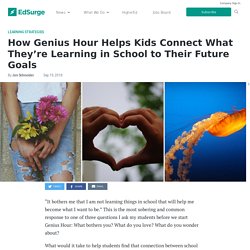
This is the most sobering and common response to one of three questions I ask my students before we start Genius Hour: What bothers you? What do you love? What do you wonder about? What would it take to help students find that connection between school and their future? Sometimes, all it takes is permission. The kind of permission I’m talking about goes beyond raising a hand to share a thought or use the bathroom. I started implementing Genius Hour in 2014 after watching Daniel Pink’s TED Talk, “The puzzle of motivation” in which he discussed Google’s 20 percent time policy (employees spent 20 percent of their week working on their own passion project).
Genius Hour has three rules: These projects are not graded. How to Build Community Leaders of Today—and Tomorrow—Through Student Genius Hours. What is Genius Hour? An Overview of Genius Hour and 20% Time in the Classroom. 12 ways to really make Genius Hour work in your class. Genius Hour empowers students to do something meaningful with their passions.
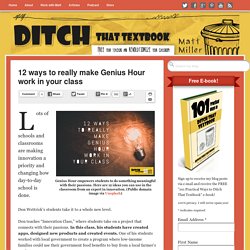
Here are 12 ideas you can use in the classroom from an expert in innovation. (Public domain image via Unsplash) Lots of schools and classrooms are making innovation a priority and changing how day-to-day school is done. Don Wettrick’s students take it to a whole new level. Don teaches “Innovation Class,” where students take on a project that connects with their passions. What Students Think About #GeniusHour Part 2: Data. Last week, I wrote about my students’ written reflections and self-evaluations for their #GeniusHour projects.
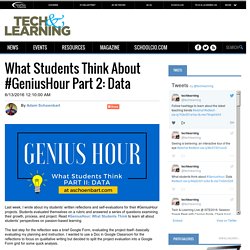
Students evaluated themselves on a rubric and answered a series of questions examining their growth, process, and project. Read #GeniusHour: What Students Think to learn all about students’ perspectives on passion-based learning. The last step for the reflection was a brief Google Form, evaluating the project itself--basically evaluating my planning and instruction. I wanted to use a Doc in Google Classroom for the reflections to focus on qualitative writing but decided to split the project evaluation into a Google Form grid for some quick analysis.
This qualitative data is really interesting for me. Find more of my recent writing on Genius Hour with Redesigning Learning Spaces, Sharing Students’ Genius: A #GeniusHour Reflection, Developing Genius: Reflecting on Choice, Passion, and #GeniusHour, Teaching Students to Conduct Action Research, and My Questions About #GeniusHour. Top Designers Share Their Secrets to Beating Creative Block. Sometimes, being creative just feels impossible.
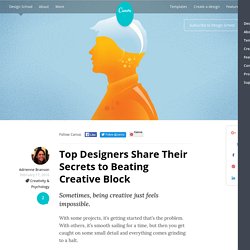
With some projects, it’s getting started that’s the problem. With others, it’s smooth sailing for a time, but then you get caught on some small detail and everything comes grinding to a halt. Both of these situations could be described as creative block. It’s a problem that plagues almost everyone in a creative field. But you have ambition. Fortunately, you’re not the only one to ever suffer through this problem. Keep reading to hear 15 different perspectives on beating creative block. 01. “Sometimes, starting out by coming up with the worst solution can help you overcome inertia. Sometimes, the hardest part of a project is just getting started. So, to break past that, don’t worry about failure – don’t even worry about necessarily creating something that you’ll even be able to use. 02. “If you can capture that bit of excitement you have at the beginning within style tiles/moodboards, then you always have something to refer to.
The 4 essentials of a successful Genius Hour. Genius Hour projects may be open ended, but there are still some ground rules What are you passionate about?
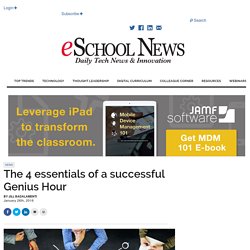
What do you want to do more than anything in the world? Well I hope you said what you are doing right now. This is not always the case. Some people hate what they are doing. As educators, we can help our students find and explore their passions. Genius Hour isn’t new concept. However, even with all this freedom, we still need some rules. Let students explore their passions – First things first: make sure kids have enough time to explore what makes them passionate in the first place. My collection of resources on #GeniusHour - Angela Maiers. Four years ago, we imagined a classroom where passion driven work was the norm; one in which students were invited and expected to experiment with ideas, discover possibilities, and make epic things happen.

This dream is now a reality. When we create a time and space for our students to strive audaciously and connect and collaborate with others, their genius is liberated, and learning, lives and worlds change. Below is a host of resources to help you launch #geniushour in your classroom. Liberating Genius in the Classroom is a free, day-by-day lesson plan for the first 20 days of implementing genius hour. Soon we will also offer a student “Genius Notebook” so students can record their reflections on the lessons and easily share them with each other and you.